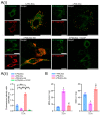Gallic Acid Ameliorates the Inflammatory State of Periodontal Ligament Stem Cells and Promotes Pro-Osteodifferentiation Capabilities of Inflammatory Stem Cell-Derived Exosomes
- PMID: 36143428
- PMCID: PMC9501550
- DOI: 10.3390/life12091392
Gallic Acid Ameliorates the Inflammatory State of Periodontal Ligament Stem Cells and Promotes Pro-Osteodifferentiation Capabilities of Inflammatory Stem Cell-Derived Exosomes
Abstract
The slow proliferation rate and poor osteodifferentiation ability of inflammatory periodontal membrane stem cells extracted from periodontitis tissues (i-PDLSCs) account for poor efficiency in treating inflammatory bone loss. Exosomes reportedly have inducible and relatively stable components, allowing them to promote inflammatory bone repair, but obtaining i-PDLSCs exosomes with the ability to promote osteodifferentiation is challenging. In the present study, i-PDLSCs were extracted from periodontal membrane tissues of patients with severe periodontitis, and in vitro induction with gallic acid (GA) significantly promoted the proliferative activity of i-PDLSCs at a concentration of 10 mM, with TC0 of 11.057 mM and TC50 of 67.56 mM for i-PDLSCs. After mRNA sequencing, we found that GA could alleviate oxidative stress in i-PDLSCs and increase its mitochondrial membrane potential and glucose aerobic metabolism level, thus promoting the osteodifferentiation of i-PDLSCs. After exosomes of i-PDLSCs after GA induction (i-EXO-GA) were isolated by differential centrifugation, we found that 200 ug/mL of i-EXO-GA could remarkably promote the osteodifferentiation of i-PDLSCs. Overall, our results suggest that GA induction can enhance the proliferation and osteodifferentiation in primary cultures of i-PDLSCs in vitro, mediated by alleviating oxidative stress and glycometabolism levels in cells, which further influences the osteodifferentiation-promoting ability of i-EXO-GA. Overall, we provide a viable cell and exosome induction culture method for treating inflammatory alveolar defects associated with periodontitis.
Keywords: aerobic glucose metabolism; exosomes; gallic acid; osteodifferentiation; oxidative stress; periodontal membrane stem cells; periodontitis.
Conflict of interest statement
The authors declare no conflict of interest.
Figures






Similar articles
-
Periodontal Ligament Stem Cell Exosomes Key to Regulate Periodontal Regeneration by miR-31-5p in Mice Model.Int J Nanomedicine. 2023 Sep 18;18:5327-5342. doi: 10.2147/IJN.S409664. eCollection 2023. Int J Nanomedicine. 2023. PMID: 37746047 Free PMC article.
-
Treatment of inflammatory bone loss in periodontitis by stem cell-derived exosomes.Acta Biomater. 2022 Mar 15;141:333-343. doi: 10.1016/j.actbio.2021.12.035. Epub 2022 Jan 1. Acta Biomater. 2022. PMID: 34979326
-
Exosomes Derived From Human Gingival Mesenchymal Stem Cells Attenuate the Inflammatory Response in Periodontal Ligament Stem Cells.Front Chem. 2022 Apr 6;10:863364. doi: 10.3389/fchem.2022.863364. eCollection 2022. Front Chem. 2022. PMID: 35464198 Free PMC article.
-
Dental Pulp Stem Cell-Derived Exosomes Regulate Anti-Inflammatory and Osteogenesis in Periodontal Ligament Stem Cells and Promote the Repair of Experimental Periodontitis in Rats.Int J Nanomedicine. 2023 Aug 17;18:4683-4703. doi: 10.2147/IJN.S420967. eCollection 2023. Int J Nanomedicine. 2023. PMID: 37608819 Free PMC article.
-
Epigenetic regulation of osteogenic differentiation of periodontal ligament stem cells in periodontitis.Oral Dis. 2023 Oct;29(7):2529-2537. doi: 10.1111/odi.14491. Epub 2023 Jan 13. Oral Dis. 2023. PMID: 36582112 Review.
Cited by
-
Mitochondria in Multi-Directional Differentiation of Dental-Derived Mesenchymal Stem Cells.Biomolecules. 2023 Dec 21;14(1):12. doi: 10.3390/biom14010012. Biomolecules. 2023. PMID: 38275753 Free PMC article. Review.
-
Mechanistic insights into periodontal ligament stem cell-derived exosomes in tissue regeneration.Clin Oral Investig. 2025 Jun 25;29(7):357. doi: 10.1007/s00784-025-06422-1. Clin Oral Investig. 2025. PMID: 40562987 Free PMC article. Review.
-
Clinacanthus nutans extract lowers periodontal inflammation under high-glucose conditions via inhibiting NF-κB signaling pathway.Front Pharmacol. 2024 Aug 13;15:1410419. doi: 10.3389/fphar.2024.1410419. eCollection 2024. Front Pharmacol. 2024. PMID: 39193343 Free PMC article.
-
Critical roles of extracellular vesicles in periodontal disease and regeneration.Stem Cells Transl Med. 2025 Mar 18;14(3):szae092. doi: 10.1093/stcltm/szae092. Stem Cells Transl Med. 2025. PMID: 39703170 Free PMC article. Review.
-
Dynamic hydrogel-metal-organic framework system promotes bone regeneration in periodontitis through controlled drug delivery.J Nanobiotechnology. 2024 May 26;22(1):287. doi: 10.1186/s12951-024-02555-9. J Nanobiotechnology. 2024. PMID: 38797862 Free PMC article.
References
-
- Abu-Saleh T. Interleukin-1 composite polymorphism as a risk factor for chronic periodontitis: A review. SADJ. 2010;65 - PubMed
Grants and funding
- 31972915/National Natural Science Foundation of China
- 82073747/National Natural Science Foundation of China
- 2021A1515111074/Guangdong Basic and Applied Basic Research Foundation
- 2021M701620/China Postdoctoral Science Foundation
- YQ2021001/President Foundation of The Third Affiliated Hospital of Southern Medical University
LinkOut - more resources
Full Text Sources

